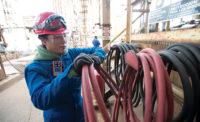A common myth in the portable gas detection industry is the concept of a “detection range” — the area around a gas detector that is monitored for hazardous gases. Believing in detection ranges may lead workers to ask questions that can result in risky behaviors.
Will my instrument detect a hazardous gas that is 5 feet away or 25 feet away?
How much will my detection range increase if I add a pump?
My team is working in the same room, don’t we just need one gas detector?
These questions come from the belief that gas detectors “search” for gases and detect them from afar. Unfortunately, this isn’t true. The discussion on this topic is important, but the answer is likely to disappoint.
For traditional portable gas detectors, the answer is easy – the only gases detected are the ones immediately in front of the instrument that diffuse into the sensors. In other words, only gases that make physical contact with sensors in the instrument are detected. Gas detectors are not capable of alerting users of hazards that are 10 feet away, or even 10 inches away.*
Know the limits of pumps
This fact leads users (and some uninformed salespeople) to recommend using a pump for personal protection applications, not simply for traditional pumped applications like confined space entries. Their logic is that a pumped instrument will pull a greater quantity of air into the sensors, thereby increasing the detection range and keeping the user safer.
The fault in this logic is that a typical instrument’s flow rate is between 250-500ml per minute. A typical adult male inhales approximately 30 liters per minute while walking – a volume that is 60-120 times greater. In other words, the flow rate of a pump is minuscule compared to a person breathing.
In order to be most effective, an instrument should be worn in the user’s breathing zone. OSHA defines a breathing zone as “a hemisphere forward of the shoulders within a radius of approximately six to nine inches.”
A small pump in the gas detector placed next to a person breathing has little impact on the environment. As a result, a pump offers minimal value for personal protection applications.
That’s not to say pumped gas detectors are not valuable in other situations. These instruments are designed for applications where an environment needs to be monitored prior to entry. In these applications, the pumped instrument pulls a sample from the distant environment to the instrument. At this point, a non-pumped instrument is identical to a pumped instrument. The sample gas diffuses into the sensors and is measured.
Benefits of tubes and probes
Should you buy a new gas detector if you are currently using an instrument with a pump for personal protection? Not necessarily. While pumped instruments don’t increase the detection range, they do offer the flexibility of drawing a remote sample at any time by adding tubing or a probe. Without a probe or sample tubing, pumped instruments offer the same level of protection as non-pumped instruments.
If you are looking to purchase a gas detector for personal protection, think carefully before choosing a pumped instrument. Unless the instrument will be used for multiple applications (e.g. personal protection and confined space entries) the pumped instrument may cause stress in the future for a few reasons:
1. Pumped instruments typically have a higher purchase price.
2. Pumps often fail when water, dust or debris is sucked into the inlet, leading to increased repair costs and downtime.
Confusing terms
A brief note about area monitoring: The same principles described above apply to area monitoring gas detectors. The gas detection industry has created confusion by using the term “area” when referring to these instruments. Traditional area monitors use the same sensor technology as portable gas detectors. Again, unless the hazardous gas reaches the face of the sensor and diffuses inside, the area monitor will not detect the hazard. Portable gas detectors and area monitors have the same detection range. Area monitors serve a noble purpose and they do it well, but only when used properly.
The limited detection range of traditional gas detectors is the reason behind a basic rule of safety – wear your gas detector in your breathing zone. The gas hazard a user should be most concerned with is the one about to enter their lungs. There is no safer place on the body for a gas detector than near the user’s nose and mouth.
*Note: Various imaging technologies exist that detect gas at a distance. These technologies are not considered in this article as they are typically used for leak detection and inspections, not personal protection applications.


